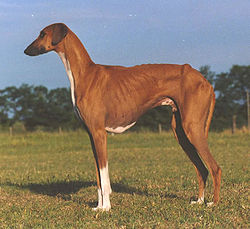This article needs additional citations for verification .(April 2021) |
| Azawakh | |||||||||||||||||||||||||
|---|---|---|---|---|---|---|---|---|---|---|---|---|---|---|---|---|---|---|---|---|---|---|---|---|---|
 Azawakh female | |||||||||||||||||||||||||
| Other names | Idi Hanshee Oska Rawondu Bareeru Wulo (formerly) Tuareg Sloughi | ||||||||||||||||||||||||
| Origin | Mali, Niger, Burkina Faso | ||||||||||||||||||||||||
| |||||||||||||||||||||||||
| |||||||||||||||||||||||||
| Dog ( domestic dog ) | |||||||||||||||||||||||||
The Azawakh is a breed of dog from West Africa. With ancient origins, it is raised throughout the Sahelian zone of Mali, Niger, and Burkina Faso. This region includes the Azawagh Valley for which the breed is named. While commonly associated with the nomadic Tuareg people, the dogs are also bred and owned by other ethnic groups, such as the Peulh, Bella, and Hausa. The Azawakh is more related to the Sloughi than it is to the Saluki. [1] [ unreliable source? ]



